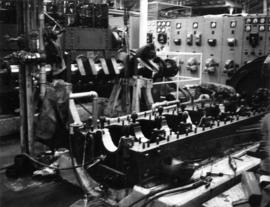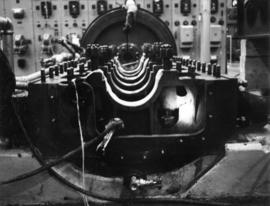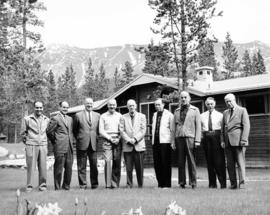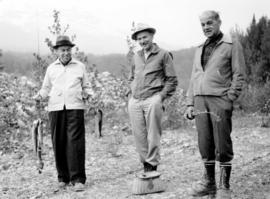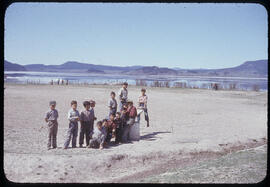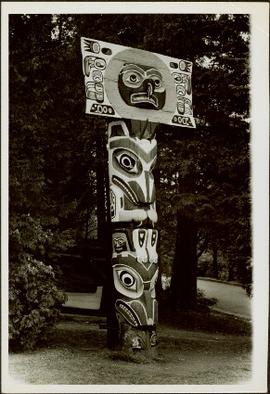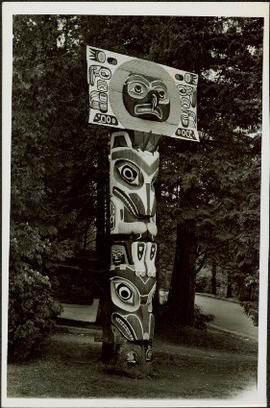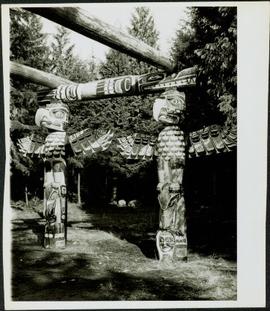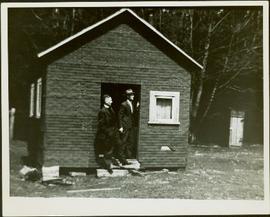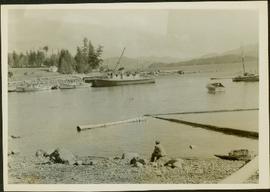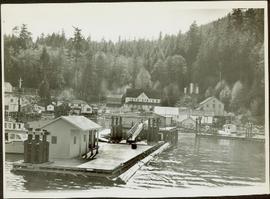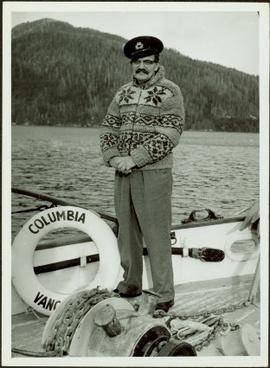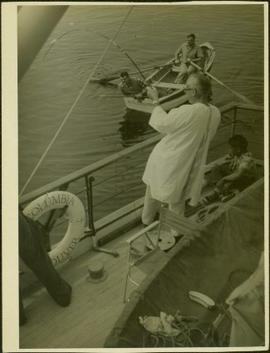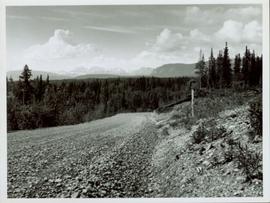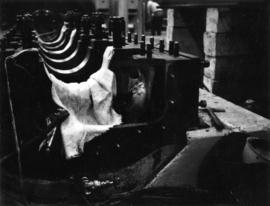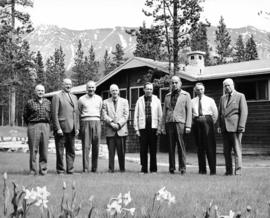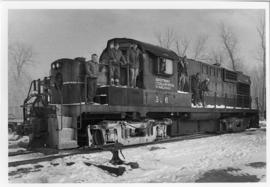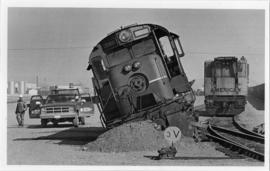Photograph depicts the large bearing cups of one of the Ruston Hornsby diesel engines that turned the generators in the power house on the Cassiar plant. Engine believed to be under repair. Saw horse, machinery, and electric panels in background.
Photograph depicts the large bearing cups of one of the Ruston Hornsby diesel engines that turned the generators in the power house on the Cassiar plant. Engine believed to be under repair. Electric panels in background.
File contains photographs depicting an award night that took place in the late 1950s or early 1960s in the old panabode Recreation Centre at Cassiar B.C.. Photos feature groups of people posed with trophies, a family posed together, a large group on stage, the audience, and musicians including individuals with a trumpet, saxophone, guitar and violin. Fred Murray (early Cassiar staff member) is featured in the 2nd, 3rd, and 4th photograph.
Photograph depicts group of nine men standing on lawn in front of building known as "House 130" or "Director's Lodge". Left to right: Andre Beguin, unknown, Charles Rainforth Elliot, Jack Christian, W. Harold Connell, Plato Malezemoff (from Newmont Mining), Tam Zimmermann, Ken A. Creery, Fred Martin Connell. Daffodils and tulips planted in foreground, trees and mountains in background. Most men featured in photo are believed to be members of Cassiar's Board of Directors; Beguin was a General Superintendent.
Photograph depicts three men with fishing gear. Trees and mountains in background. Left to right: Plato Malezemoff (holding fish), Jack Christian, Tam Zimmermann.
File contents relate to: Engineering. Document type(s) include: instructions, correspondence.
Subseries contains records related to logging operations. Includes scaling booklets, monthly scale return, lumber tallies and other records of logging and logging operations.
Item is a report for EP 387 entitled "Direct Seeding of White Spruce, Alpine Fir, Douglas-Fir, and Lodgepole Pine in the Central Interior of British Columbia" by A.E. Prochnau of the Research Division, B.C. Forest Service.
Photograph depicts a large white dome structure aboard a weather ship.
Photograph depicts the bow of a weather ship swamped with water after waves broke over the side of the ship.
Photograph depicts a weather ship sailing over rough waves.
Photograph depicts a partially obscured image of a wave breaking over a weather ship.
Photograph depicts rough water breaking over the bow of a weather ship.
Photograph depicts a wave breaking over the bow of a weather ship.
Photograph depicts a rainbow over a large body of water.
Photograph depicts a weather balloon as its rising into the air.
Photograph depicts a weather balloon rising with clouds in the background.
Photograph depicts a sunset over water with a beach in the foreground.
Photograph depicts a sunset over a large body of water with a beach in the foreground.
Audio recording is of an interview by Bridget Moran with both Mr. George Henry and Mr. Arnold Davis to discuss their memories of the early town site development of South Fort George and Central Fort George c.1910-c.1917. Mr. Henry was born in 1882 and his family arrived in Quesnel in 1909. Mr. Henry’s interview is primarily about his work as a captain on the BX Sternwheeler up until the time of the railroad arriving in Prince George in 1914. Mr. Davis, who was a Sherriff in Prince George, recalls his childhood memories of Fort George and Central Fort George c.1917. Mr. Davis also discusses his family roots from Ireland, the family’s arrival in Fort George from Ashcroft in 1917 and memories of his father who worked on the sternwheelers on the Fraser River.
Audiocassette Summary
Scope and Content:
Interview with Mr. George Henry
Mr. Henry was born in 1882 in Northern California and his family came to the Cariboo in 1909. He recalls riding his bicycle from Ashcroft to Quesnel in 3 days to find work with the BC Express Company.
Mr. Henry recalls working on the BX and describes the sternwheeler trip from Quesnel to South Fort George; it was a 3 hour trip from Quesnel and included two mail stops ;
Henry recalls an accident onboard the sternwheeler going through the Fraser Canyon (see p.p.11-12 of
Prince George Remembered)
Mr. Henry describes his homestead at South Fort George
Mr. Henry describes the BX sternwheeler being aground at South Fort George c.1920
Mr. Henry recalls spending winters in South Fort George in his log cabin; that work was “plentiful” in 1910 and the population at “about 700”
Mr. Henry notes that the “Indian reserve was at the Hudson’s Bay company” and that the native population was at “about 50”
Mr. Henry recalls the early commercial businesses in South Fort George c.1910 including the Northern Hotel; the candy store and ice cream store and theatre.
Mr. Henry describes the start of the town site of Central Fort George as a “viable little town” which started once the Grand Trunk Railway arrived and recalls the change in population between South Fort George & Central Fort George.
Henry recalls how all the workers came and lived in tents in Central Fort George.
Mr. Henry was not happy about the arrival of the railway as it meant he lost his job on the sternwheeler – he recalls that “us old river rats were just lost” (see p.p.34 of Prince George Remembered)
Bridget then asks Mr. Arnold Davis to recall his memories of early South Fort George
But first asks him to describe his family’s roots (See p.p. 1-2 of Prince George Remembered)
Scope and Content:
Interview with Mr. Arnold Davis
Davis notes he is 6th generation Canadian; family came from Ireland and his grandfather’s brother Jeff Davis became the President of the Confederate States of America.
Davis refers to his mother’s family being on the Prairies at time of the trial of Louis Riel
Davis explains that his grandfather first homesteaded at Banff; then Kamloops; then Ashcroft and on to South Fort George in 1917.
Davis’ father worked for the BC Express Company and he recalls being on the sternwheeler as a child during same time that George Henry worked the boats. Recalls workers on the boat; eating pie on the boat baked by the Chinese cook; (See p. 33 of Prince George Remembered)
Davis recalls the town site of South Fort George. He notes it had a population by 1917 of only “about 300” and that the “boom was over”
Davis describes location of various businesses in South Fort George including the Rex Theatre, George St. Poole Room, McKay Bros. Grocery store, Drugstore, Bairds, Peters Butcher Shop.
Davis recalls that there were many “Yukoners” here at the time and recalls a tale about an old Yukoner
Mr. Davis recalls other people who worked on the BX with his father including Margaret “Granny” Seymour’s father;
Mr. Davis recalls riding up and down the river to Foley’s Cache on the sternwheeler as a child
Mr. Henry then speaks up and recalls trips on the sternwheeler with Arnold Davis on the boat as a child
Tape ends
Audio recording consists of speeches and related forum questions at a public forum in Canada (Ottawa?) in post-WWII period. Speaker refers to this as the “post-McCarthy era”. The MC notes that the “CND” founders are on a speaking tour in the U.S., so it is possible this recording is a component of that tour. Speeches appear to be by Canon L. John Collins & Diana Collins who were both organizers of the Campaign for Nuclear Disarmament, an organization founded in 1958, which by 1960 was the largest mass movement in Britain. The CND organizers included philosopher Bertrand Russell, and chair of the Campaign was Canon L. John Collins and his wife Diana Collins. John & Diana Collins speak on the state of protest groups for nuclear disarmament in Britain, U.S. and Canada. The end of forum includes a political motion that the campaign for nuclear disarmament in Canada will renew itself to approach politicians to oppose arms development in Canada whether at home or abroad.
Audiocassette Summary
Side 1
00’01” -4’06” recording starts in progress with speaker possibly Cannon John Collins, chairman of the Campaign for Nuclear Disarmament
4’07-11’25” recording of woman, possibly Mrs. [John] Diana Collins of the CND; answering question from audience on how to stop nuclear war from happening
11’26-21’39” continued speeches; includes position of [Anglican?] church on nuclear disarmament and position of the Canadian Peace Institute
21’40-24’31” motion on nuclear disarmament in Canada; passed.
File contains calculations of mine revenue losses due to the strike.
Sans titreGroup stands in foreground on what appears to be a wooden teeter totter. Fence crosses midground in front of water, and hills can be seen on opposite shore in background. Handwritten annotation on recto of mounted slide reads: "play ground in Legak [sic]".
File includes:
- C.I.F. Annual General Meeting October 1959 Program
- member correspondence
- documents relating to C.I.F. 1960 meetings
- programs and information bulletins.
Photograph depicts a small totem pole in front of trees and a roadway. Photographer’s stamp on verso: “W.E. Nicholson, 268 E. 10th, Vancouver 10, B.C.”
Photograph depicts a small totem pole in front of trees and a roadway. Photographer’s stamp on verso: “W.E. Nicholson, 268 E. 10th, Vancouver 10, B.C.”
Photograph depicts a close-up of Alert Bay house posts adorned with First Nations carvings. Photographer’s stamp on verso: “W.E. Nicholson, 268 E. 10th, Vancouver 10, B.C.”
Photograph depicts a close-up of a totem pole behind a fence overlooking a wharf and a ship named Camosun. Photographer’s stamp on verso: “W.E. Nicholson, 268 E. 10th, Vancouver 10, B.C.”
Photograph depicts an unidentified priest and man standing in the doorway as a small house under construction.
Photograph depicts J.J. Claxton sitting on a rocky shore with the Columbia Mission Ship in the background at dock at Bendickson. Handwritten annotation on verso reads: “Bendickson”; “JJ Claxton on rock”; photographer’s stamp on verso: “W.E. Nicholson, 268 E. 10th, Vancouver 10, B.C.”
Photograph depicts a wharf and buildings along the shore of an unidentified fishing community with a forested environment visible in the background.
Photograph depicts James Joseph Claxton wearing a Cowichan sweater and military hat standing on the deck of the M.S. Columbia with a forested mountain visible in the background. Handwritten annotation in pencil on verso reads: “JJ. Claxton (JJC), Sweter [sic]: woolspun sweater knit by JJC’s sister Eileen Jackson My mother. SKJ Kelowna. My sister Barb LeDuc Kamloops has the sweater now.”
Photograph depicts two men in a row boat, one rowing and one holding a peugh (J.J. Claxton) and watching the catch being reeled in on the fishing pole of another man wearing a hospital gown. A small boy on the deck watches. Handwritten annotation in pencil on verso reads: “JJC x”
View of snow capped mountains in the distance, vast rolling treed hills in mid ground and a gravel road in the foreground. Road sign indicating severe curve in road situated at the right of the gravel road. Handwritten annotation on verso in pen reads: “Cassiar – Stewart highway”
File consists of a BC Department of Commercial Transport Railways Branch publication compiled by R.E. Swanson entitled "A History of Railroad Logging".
File consists of Runka's 1960 UBC Aggies yearbook.
This Canadian National Railways (CNR) Office of the Locomotive Foreman (Boston Bar) log book from 1958-1960 contains daily descriptions of weather, train timings, inspections, and issues arising. Also includes accountings of diesel units arriving and departing at Boston Bar.
Photograph depicts the large bearing cups of one of the Ruston Hornsby diesel engines that turned the generators in the power house on the Cassiar plant. Engine believed to be under repair. Electric panels and unidentified individual in background.
Photograph depicts group of eight men standing on lawn in front of building known as "House 130" or "Director's Lodge" (see item 2000.1.1.3.19.88). Left to right: Nick Gritzuk, Charles Rainforth Elliot, Jack Christian, W. Harold Connell, Plato Malezemoff (from Newmont Mining), Tam Zimmermann, Ken A. Creery, Fred Martin Connell. Daffodils and tulips planted in foreground, trees and mountains in background. Most men featured in photo are believed to be members of Cassiar's Board of Directors.
Photograph depicts group of eight men standing on lawn in front of building known as "House 130" or "Director's Lodge". Left to right: Nick Gritzuk, Charles Rainforth Elliot, W. Harold Connell, Jack Christian, Fred Martin Connell, Ken A. Creery, Plato Malezemoff (from Newmont Mining), Tam Zimmermann. Trees and mountains in background. Most men featured in photo are believed to be members of Cassiar's Board of Directors.
File consists of issues of the literary periodical entitled "Evergreen Review", including volume 2 number 7 through volume 4 number 14.
Photograph depicts a stationary B.C.R. locomotive # 586 on a wintry track with seven men on board posing for a photo. Part of a set of 17 black & white photographs of British Colombia Railway & its precursor, Pacific Great Eastern Railway (1912 - 2004) in British Columbia. Photos depict locomotives, railroad cars, and crew members.
Photograph depicts B.C.R. locomotive # 586 derailed with two men arriving in a company truck. Gravel and switch is visible in the foreground while industrial storage tanks are visible in the background. Photographer: "Brock Gable" stamped in red on verso. Typed note on verso reads: "When we say May Day, we mean May Day.......specifically May1, 1985. Our locomotive, BCR # 586 made the front page of the "Citizen" that day. though not the way anyone intended. In fact, it was downright embarrassing and unflattering. Nearing the end of its career, # 586 was involved in a minor hist and run in the BCR yard and parted company with the rails. As is evident in the picture, BCR's big hook" is standing by and help is on the way. No! we don't know if anyone got the other guy's license. (Photo Credit: Brock Gable ///Citizen). Part of a set of 13 black & white photographs of British Colombia Railway & it's precursor, Pacific Great Eastern Railway (1912 - 2004) in British Columbia. Photos depict locomotives, railroad cars, and crew members. «
File consists of 1 audiocassette of interviews possibly by Bridget Moran with Arnold Davis and Claude Foot.
Sans titreConsists of 165 black and white photographs depicting Northwest Coast communities including Bella Bella, Rivers Inlet, Port Simpson, and Prince Rupert between approximately 1900 and 1920. Also includes postcard images of ships and boats on the North Coast belonging to the Large family, from Reverend Large's son Dr. R.G. Large. Also includes 39 colour slides ca. 1960 of ship scenes and weather balloon launches from the Dr. R.G. Large family.
Sans titrePhotograph depicts two men on the deck of a weather ship.
Photograph depicts a weather ship sailing in rough weather with waves spilling over the side of the ship.
Photograph depicts a wave breaking over the stern of a weather ship in stormy weather.
Photograph depicts the bow end of a ship getting swamped by a wave in rough water.
Photograph depicts a weather ship in rough water with water spilling onto the bow end of the ship.
